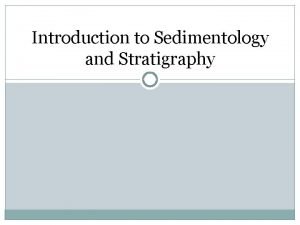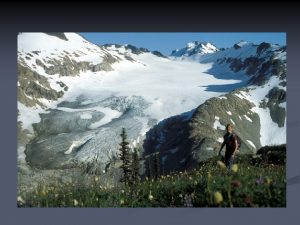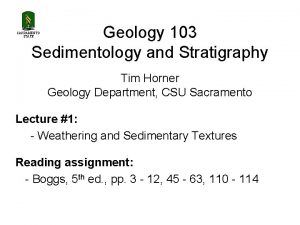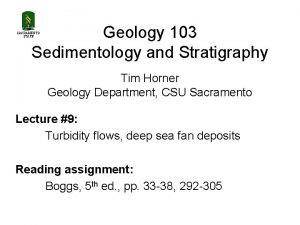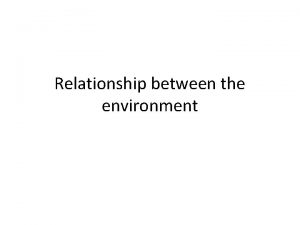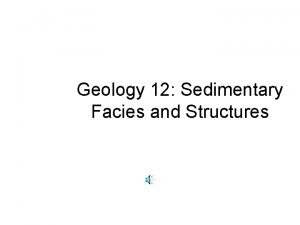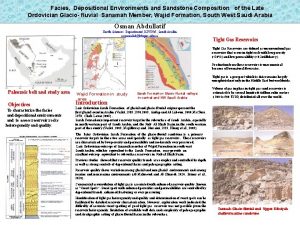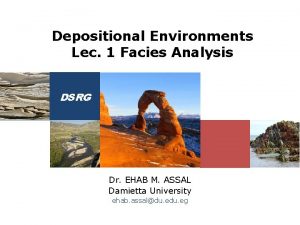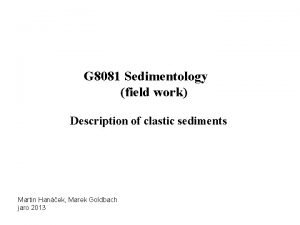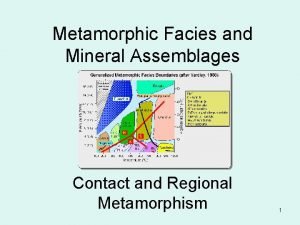Field Sedimentology Facies and Environments UNIT 5 FIELD










- Slides: 10

Field Sedimentology, Facies and Environments UNIT - 5

FIELD SEDIMENTOLOGY �A large part of modern sedimentology is the interpretation of sediments and sedimentary rocks in terms of processes of transport and deposition and how they are distributed in space and time in sedimentary environments. �To carry out this sort of sedimentological analysis some data are required and this is mainly collected from exposures of rocks.

Field equipment �Only a few tools are needed for field studies in sedimentology and stratigraphy A notebook to record data is essential A hand lens (10 magnification) A compass – clinometer A geological hammer. For the collection of samples, small, strong, plastic bags and a marker pen are necessary. A small bottle containing dilute hydrochloric acid is very useful to test for the presence of calcium carbonate in the field Camera A GPS (Global Positioning Satellite) receiver

Field studies � The organization of a field program of sedimentary studies will depend on the objectives of the project. � When an area with sedimentary rock units is mapped the character of the beds exposed in different places is described in terms given below. � To describe the lithology the Dunham classification can be used for limestones, and the Pettijohn classification for sandstones. � Other features to be noted are bed thicknesses, sedimentary structures, fossils (both body and trace fossils) � Rock color and any other characteristics such as weathering, degree of consolidation and so on.

Graphic Sedimentary Log � A sedimentary log is a graphical method for representing a series of beds of sediments or sedimentary rocks Examples of patterns and symbols used on graphic sedimentary logs

PALAEOCURRENTS �A palaeocurrent indicator is evidence for the direction of flow at the time the sediment was deposited, and may also be referred to as the palaeoflow. �Palaeoflow data are used in conjunction with facies analysis and provenance studies palaeogeographic reconstructions. to make

Palaeocurrent indicators �Two groups of palae-ocurrent indicators sedimentary structures can be distinguished in Unidirectional indicators are features that give the direction of flow. Flow axis indicators are structures that provide information about the axis of the current but do not differentiate between upstream and downstream directions.

Unidirectional indicators � Cross-lamination is produced by ripples migrating in the direction of the flow of the current. The dip direction of the cross-laminae is measured. � Cross-bedding is formed by the migration of aeolian and subaqueous dunes and the direction of dip of the lee slope is approximately the direction of flow. � Clast imbrication is formed when discoid gravel clasts become oriented in strong flows into a stable position with one of the two longer axes dipping upstream when viewed side-on.

Flow axis indicators � Primary current lineations on bedding planes are measured by determining the orientation of the lines of grains. � Groove casts are elongate scours caused by the indentation of a particle carried within a flow that give the flow axis. � Elongate clast orientation may provide information if needle- like minerals, elongate fossils such as belemnites, or pieces of wood show a parallel alignment in the flow. � Channel and scour margins can be used as indicators because the cut bank of a channel lies parallel to the direction of flow.

Measuring Palaeocurrents �The most commonly used features for determining palaeoflow are cross stratification, at various scales. �As many as possible data points should be collected to carry out palaeocurrent analysis. �The statistical validity of the mean will be improved with more data �If only a general trend of flow is required for the project in hand, then fewer will be required.
 What are sedimenta
What are sedimenta Sedimentology
Sedimentology Sac state geology
Sac state geology Sedimentology
Sedimentology Facies esclerodermica
Facies esclerodermica The widening set of interdependent relationships
The widening set of interdependent relationships External environment and accountability of schools
External environment and accountability of schools Every agent is rational in an unobservable environment.
Every agent is rational in an unobservable environment. Relationship between micro market and macro environment
Relationship between micro market and macro environment International business chapter 5
International business chapter 5 International business environments and operations
International business environments and operations
